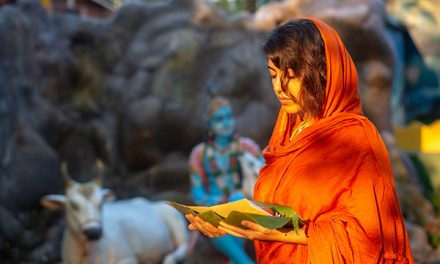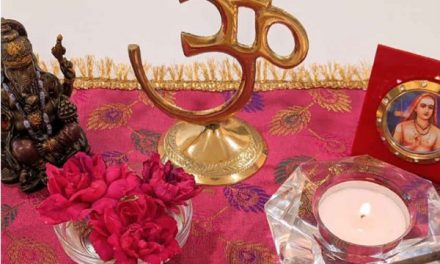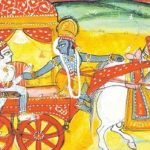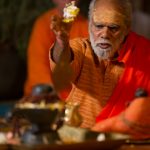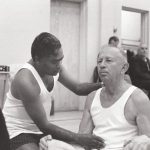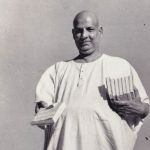 Reaching Home, Finding Peace
Reaching Home, Finding Peace
The Role of the Guru in Our Spiritual Life
by Swami Swaroopananda
Introduction: What is a Guru?
Swami Sivananda, Swami Vishnudevananda and all the yogic scriptures talk about the importance of the Guru or spiritual preceptor. The word “Guru” literally means the one who dispels the darkness of ignorance by bringing in the light of knowledge. There are two types of knowledge found in the Vedas, or sacred Hindu scriptures.
 The first type of knowledge teaches us how to take care of the world, and the second teaches us how to transcend the world. Without learning how to take care of the world, we do not have the foundation for transcending the world. Thus the study of both topics is essential for our spiritual life, and the study of both these topics requires a Guru.
The first type of knowledge teaches us how to take care of the world, and the second teaches us how to transcend the world. Without learning how to take care of the world, we do not have the foundation for transcending the world. Thus the study of both topics is essential for our spiritual life, and the study of both these topics requires a Guru.
Who is a True Guru?
According to the Upanishads, there are two qualifications that a person must have in order to be considered as a Sat Guru (perfect Guru). The Guru needs to be a master of the scriptures (Brahmasrotriya) and to have a direct real- ization of the Self or Brahman (Brahma-nishtha). Such a person knows the yogic path from beginning to end and therefore has the capacity to teach it to others.
Another quality that a Guru must have is love, compassion, and caring for other people. Compassion is the only motivation for the Guru to teach and transmit spiritual knowledge to others. For a true Guru there is no other motivation, because a true Guru does not have any per- sonal desires. Swami Sivananda describes the Guru as the richest person in creation, richer than any emperor or king, because in his or her possession is the entire wealth of the Lord.
The Guru is a person who has fulfilled all possible human desires. Having fulfilled all desires, what possible motive might they have to teach us other than love and compassion? They teach because of Grace. By definition, a true Guru must be completely selfless. He or she does not expect anything in return; there is no personal interest there, only love.
The Guru can save us from the greatest disease, which is perpetual suffering caused by our spiritual ignorance, and so the Guru is our greatest savior. That is why we worship the Guru. Yet, the Guru has no desire to be worshipped; the need to worship is ours. A Guru will never point us toward himself; rather, he or she always points us towards our own Self. Their only purpose is to direct us towards the knowl- edge of our true nature; this is the reason they manifest in our life..
Guru is God Himself
According to the yogic scriptures, the Guru, the Self, and God are one and the same. The Guru that you see outside is identical with your own Self, which is within, and is also identical with God whom we worship. By saying that the Guru is God, we do not mean that the physical body of the Guru is God, but that God reveals Himself to the aspirant through the form of the Guru. God comes to each one of us in a personal way, in the form of our personal Guru. Whoever is the Guru for one person may not be the Guru for another person.
Why does God manifest in our life in the form of the Guru? According to our tradition, the Jiva, the individual soul, is going through a long path, a Divine path of purification that takes many lifetimes. When the heart is pure enough, the soul begins to yearn to know the truth, or God. It prays, “O God, please show yourself to me, please come to me.” God listens to our prayers and appears in our life in the form of the Guru to show us the path to Himself, which is the path to our own true Self.
It is said that when the disciple is ready, the Guru shows up at the disciple’s doorstep. ‘Ready’ here means pure. When there is enough purification in the heart and the mind the Guru appears. Once the Guru takes responsibility for a disciple, the Guru will never leave the disciple; our Guru will stay with us until we realize the Self, even if it takes many lifetimes.
Necessity of a Guru
People often ask: how important it is to have a Guru? Do we really need a Guru to progress on the spiritual path and attain the goal? If so, must the Guru be in a physical human form? The answer is that having a Guru is essential and ex- tremely important for those who are living a spiritual life. In fact, it is the most important thing. The Upanishads declare that one who has a Guru knows while one who does not have a Guru does not know.
In our tradition, knowledge comes only through a Guru, not through books or any other means. Thus, we need a living spiritual master in a physical form. There are few exceptions to this rule. There are great yogis and saints like Dattatreya and Ramana Maharshi who did not have a Guru in a physical form. Yet, these were rare exceptions. Most of us need a human Guru in a physical form to guide us to our goal.
How to Find a Guru
Clearly, a Guru is necessary, but how can we find one? First and foremost, we need to desire a Guru. If we truly have a powerful desire to find our teacher, eventually we will find him or her. It is said that when the heart and the mind are pure, the Guru shows up at our doorstep. But this does not mean that we should sit idle. Rather, we should actively search for our Guru. If we wish to learn yoga, we need to find a teacher who can teach us yoga. If we wish to realize the Self, we need to find a teacher who has realized the Self and who can teach us how to attain this goal. In this pro- cess of searching for a teacher, we meet different teachers.
They enlighten us and open many gates for us. Eventually, we reach our Guru. At that moment, we enter the path that leads to freedom, to spiritual liberation. Then we can be certain that we have reached the last leg of our spiritual journey.
Desiring and searching for a teacher should be combined with prayer. If you wish to find your teacher, pray to God to send you your teacher. Pray hard, with a sincere heart: ‘Oh, Lord, help me find my Guru.’ Prayer is a very effective method. Another method, which is the most important and powerful one, is meditation.
In deep meditation, if you sow the seed of finding your teacher, that seed will sprout, and you will find your teacher. If you combine all these methods – desiring a teacher, praying, meditating, and actively searching – you will soon, if it is within your destiny, find your teacher. When this happens, it seems that we have finally found our teacher, but truly, it was the teacher who has found us.
How to Recognize Your Guru
Still people may wonder: ‘How do I recognize a teacher as a true teacher, and how do I know that this is my own per- sonal teacher?’ You know that you have found your Guru because in his or her presence you find peace. You feel as if you have reached home. You were restless, you were searching, and finally you found what you were looking for. In the presence of your Guru you feel content, you do not have any other desires or needs.
When we were in the presence of Swami Vishnudevananda, we felt like we did not need anything else. To be with him was enough. Yet, he did not allow us to simply sit in his presence for too long. He always sent us to do some karma yoga.
In the presence of your Guru you begin to flourish, and you are ready to follow the Guru’s instructions. Then you start to grow from within. This growth is a long process. It may take your entire life, but you are content because you found your Guru and you have no doubt. Thus, when people ask how one knows that they have found their Guru, the an- swer is, ‘When you find your Guru, you know’.
The Characteristics of a True Teacher
A true teacher is someone who can guide us in such a way that we are able to experience the teachings ourselves. Additionally, there are other characteristics, like purity, hon- esty, ethical qualities, wisdom, and skill in guiding others. Most importantly, we should seek a spiritual preceptor who is following the spiritual path from beginning to end, is skillful in guiding others to do the same and has a direct experience of the teachings.
We may meet a teacher but may not be sure if he or she is a true Guru. How can we tell? The best way to test is through our own spiritual perception, by observing the impact of their spiritual teachings on ourselves. We need to take enough time to test the teachings. It may take years, but eventually, we will be able to recognize the actual value and authenticity of a spiritual teacher.
What we wish from the teacher is not to learn theory, but to learn how to practice and experience the teachings. After a few years you can look within and ask, ‘Am I experiencing the teachings? Did the preceptor fulfill his or her promises to me? Did they act in a way which is consistent with the teachings?’ If the answer is ‘yes’, then you know that this is a true, authentic, genuine teacher.
But we must keep in mind that the Guru has a human side as well as a Divine side. The guidance for the disciple is to focus only on the Divine side of the teacher, never on the human side. For example, your Guru may help you to realize the Self, but your Guru may not know mathematics or engineering. There may be many things that are worldly in nature that the Guru does not know. But the Guru can guide you wonderfully on the spiritual path. Thus, we need to remember these two sides of the Guru. If we are disappointed by the fact that the Guru also has a human side, we may not benefit from his teachings, from his presence, and from his Grace.
What Does the Guru Teach?
The Guru teaches us how to transcend samsara or the cycle of suffering. The source of all our suffering is ig- norance regarding our true nature. The Guru imparts to us a special kind of knowledge by which this ignorance is removed. When this ignorance is removed, the cause for all possible suffering is also removed. Thus, the Guru gives us a method to rid ourselves of ignorance and pain. This method has many names.
In our tradition we call it ‘yoga’. The word yoga has two primary meanings. In the Bhagavad Gita, Lord Krishna says that “Yoga is the sepa- ration from the union with pain.” (Ch. 6, v. 23). The sec- ond definition of Yoga is the realization of the oneness of the individual consciousness and the Supreme Conscious- ness. Ultimately, we do not accept a real separation; we do not believe that the individual consciousness is truly separated from the universal consciousness.
We believe that there is only one consciousness, and that separation is only an appearance. Yoga is that knowledge which re- moves the apparent separation between the human being and God and the false idea that the Self is different from Brahman or God.
The Guru teaches us how to realize our true nature, which essentially is one with God. This knowledge is not theoret- ical, but practical. Swami Sivananda teaches that an ounce of practice is worth tons of theory. The most important part in the teaching of the Guru is the practice, because the practice is the method of attaining the goal of life.
The Guru as “Doctor”
The scriptures often use the analogy of medicine. The Guru is seen as a doctor, the disciple as the patient. The disease that needs to be removed is our spiritual ignorance or misapprehension of reality: not knowing who we are, and hav- ing the wrong notion about ourselves, the world and God. The symptom of this disease is our suffering. The medicine that the doctor gives us in order to cure us from this disease is the teachings.
Just as the doctor evaluates the condition of the patient and prescribes a remedy that specifically fits the person and his condition, so does the Guru apply a specific remedy for each of us according to our specific needs, condition and level of spiritual progress.
Swami Vishnudevananda gave general teachings to all, but he also offered specific teachings to different individuals according to their needs. The individual teachings were not formal; they came in different ways, many times through instructions in karma yoga. Thus, the Guru always gives in- dividual attention to his disciples.
The Guru heals us from our spiritual disease by offering us a series of practices. The purpose of these practices is to remove the cataract of ignorance and to allow us to see our own Self, the world and reality as they truly are. Then the causes of suffering and suffering itself disappear, and consequently our capacity to help others increases tremendously.
In other words, when we heal, we ourselves become healers. But there is one important thing to remember: the Guru can only prescribe the medicine, it is still up to us to take it, to apply the remedy by practicing the teachings. Even the best doctor cannot heal us if we do not agree to be healed, if we have no desire to become healthy, if we do not take the medicine.
Faith is extremely important in this process. Even in medi- cine, we hear about the placebo effect. Placebo means that when you have faith in something, that faith itself can heal you. It is not the medicine that heals but the faith in the medicine that heals. Similarly, in our spiritual life, if we have faith, shraddha, in our Guru and in the teachings, and if we apply the teachings with faith, we are much more likely to succeed. Faith is important because if we lose faith, we will not apply the teachings. And even if we do try to apply them, without faith they will not be as effective.
Just like a good doctor, the teacher is giving us the medi- cine and also instructing us how to take it. And along the way, the Guru will change the medicine according to our progress. Slowly, our spiritual preceptor will take us to the healthy state, the state in which we realize our oneness with God, the state in which we realize our true nature and attain spiritual liberation.
How to be a Disciple
Once you recognize your Guru and accept him or her as your Guru, then you are also ready to accept the Guru’s spiritual instructions and put them into practice. You spend time with your Guru so that the Guru can guide you and correct you. Through a gradual process, the teacher brings you to the point where you start to experience the teach- ings directly. Along the way, there are things that the disci- ple must learn. This is a very long process that takes many years. Eventually, a true Guru can take the disciple all the way on the spiritual path, from beginning to end.
The relationship of the disciple to the Guru is a relationship of love and devotion. For some, it is love at first sight. For others, it is a longer, slower process. For some it is a qui- et and peaceful relationship of love and devotion, called Shanta Bhava. They feel the presence of the Guru as pro- found peace. For others it is more dynamic. Sometimes the disciples feel an ache of longing when they are physically far away from the Guru.
Other times, even if the Guru is physically far away, they can still feel the Guru’s presence within their heart. The disciple’s love for the Guru constantly grows and evolves. This is not a normal relationship with a logical progression in which one comes to the Guru in order to learn and after a certain number of years the learning is complete. The relationship is spiritual, and it is of the nature of bhakti, of love and devotion which manifests in our life and which constantly grows.
The process is gradual and can also develop through pain. The disciple may have a lot of emotions toward the Guru and these emotions may come with great intensity. But eventually these emotions will purify, will clear up and will become love or devotion. The connection between the Guru and the disciple is extremely powerful. It is a deep and long connection that crosses lifetimes, many lifetimes.
How to Get Close to the Guru
The best way to get close to the teacher is to follow his or her spiritual instructions. The teachers do not desire for us to be attached to them. Their goal is to introduce us to our true, Divine nature. They wish to show us the way to freedom, to introduce us to that reality which is absolutely free, which is of the nature of existence, consciousness and bliss.
Nothing can make them happier than seeing us attain this goal. But they also know that there is a long and often painful process of purification that they must take us through before we can reach the goal. Through their associ- ation and through their guidance we purify and eventually attain our goal which is Self-Realization or God-Realization.
Self-realization is not ego realization. On the spiritual path we are moving from selfishness to selflessness. Therefore, the first instruction that any spiritual teacher will give us would be the injunction “serve” then “love”, then “give.” These were the first three instructions that Swami Sivananda gave to his disciples.
For example, he instructed Swami Vishnudevananda to go to the West as people were waiting there to receive the teachings. And Swami Vishnudevananda followed the instruction, even though it was painful for him to leave his teacher, to leave his country, to leave the Himalayas and the Ganges which he loved. But he was a good disciple and he followed the instructions of his beloved teacher. And until the end of his life, everything that he did was under the guidance of his Guru Swami Sivananda.
This made him feel very close to Swami Sivananda. Therefore, if you want to get close to your Guru, try to follow his or her instructions as much as you can, even though this is not easy, it may even be extremely difficult.
The Legacy of Swami Vishnudevananda
Swami Vishnudevananda was our Guru, and we had the direct experience of being with him. He was very human from many points of view, but he also had a Divine side, and those of us that lived with him could clearly see both sides. His purpose was to help us transcend our own human side, our own little ego, to transcend the realm of suffering and to move into the realm which is beyond samsara—the realm of our true Self. This is what he taught us, and he did it in a very marvelous way.
He first taught us how to take care of the world, and then, how to transcend the world. Before leaving his body, he told us to take care of this organization. Just before leaving to India for his last journey, he gathered his senior disciples and he spoke to each one of us. He went from one person to the other and said: “Be a good acharya, be a good acharya”. We asked him what a good acharya meant and he said: “A good acharya is one who takes care of this organization.” And we asked, “Why?” He said, “Because this organization is my body.”
What happens when we do not take care of our body? We are un- able to do the practices that we need to in order to realize the Self, nor are we able to serve others. Similarly, Swami Vishnudevananda taught us that if we do not take care of this organization, we will neither be able to take care of others, nor we will be able to do what is necessary in order to attain our goal in life, which is Self-realization. These were his last words to us before leaving for India for the last time and before leaving his body.
He left us with this heritage to carry on the mission of Swami Sivananda, which he carried faithfully for so many years. Since he left his body, each one of his disciples has been doing their level best to carry on this mission. We all know that our duty is first to realize ourselves what he taught us, and then to share with others whatever we received from him. These are the two things.
There is nothing else to be done. Swami Vishnudevananda is a very good example of a real Guru because of his profound humility and because of his great devotion to his teacher. He refused to be called a Guru and even scolded us when we did. When we came to ask for his blessings, he would say “My blessings are cheap, go to the Master, go to Swami Sivananda.” He did not call this organization by his own name; he gave it the name of his Guru, Swami Sivananda.
For him, Swami Sivananda was everything, and he himself was nothing. He never considered himself to be a yoga master, although so many people all over the world considered him to be a great master. As a person, he was very humble; his devo- tion to Swami Sivananda was second to none, and he was a supreme practitioner and a great yogi. Still, until the last moment of his life, everything he did, he did for his Guru, his master, Swami Sivananda.
Swamiji was a wonderful example for all of us of the relationship between Guru and disciple. He was an exemplifica- tion of a perfect disciple, and whoever is a perfect disciple can also be a perfect Guru, a Sat Guru. I personally believe that before Swamiji left his body, he realized the goal of his life, and he blessed all of us. When he was asked by one of his disciples, “What should I do in order to realize the Self?” he said: “Practice karma yoga for thirty years, and don’t look back, and you will realize the Self.”
This was his mes- sage: “Don’t think about yourself. Whatever you do—even your own practice, dedi- cate it to the entire humanity.” Do ab- solutely nothing for your own sake. Do everything for oth- ers. Even sadhana. Even your own realization. This was his teaching, and this is a wonderful teaching. When we saw him, we saw his Guru, Swami Sivananda. I never met Swami Sivananda, but seeing Swamiji, I believe I saw Swami Sivananda.
When you see a good disciple, you see the disciple’s Guru, and this is how it was in the case of Swamiji. And we pray that all of us will be able, even to a small degree, to emu- late the example of our own Guru, Swami Vishnudevananda, both as a disciple, and as a teacher, as a practitioner, and, most importantly from his point of view, as a servant of humanity.
Swami Swaroopananda is the acharya of Sivananda Yoga Centres and Ashrams in the Middle East and in the Bahamas and is one of the foremost disciples of Swami Vishnudevananda.

